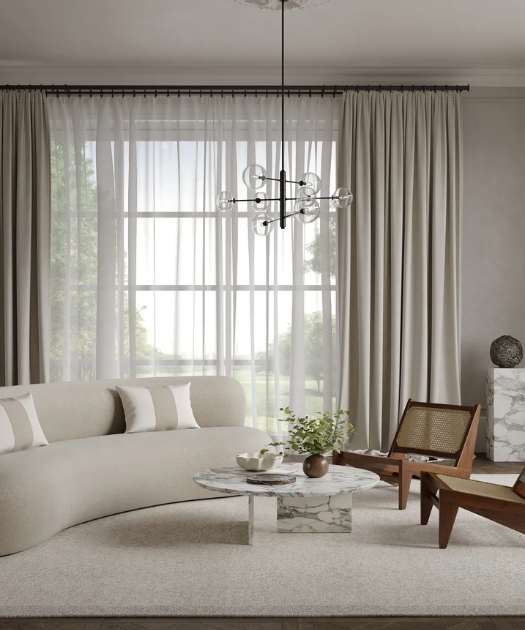The Japandi style blends Japanese and Scandinavian design for serene, minimalist living spaces connected to nature.
This guide offers 9 ideas to bring the tranquil Japandi aesthetic to your living room – from choosing muted colors and natural materials to incorporating greenery and handcrafted elements.
Learn how to thoughtfully curate an inviting, sustainable sanctuary that soothes the senses and promotes well-being.
Japandi Living Room Ideas
The Japandi design style artfully blends the simplicity and functionality of Scandinavian aesthetics with the natural elements and tranquility of Japanese design principles.
To create a living room that reflects this harmonious fusion, there are several key ideas to consider.
1. Choose a neutral, muted color scheme
Embracing a neutral, muted color scheme is the foundation of a Japandi living room. Think beige, taupe, oatmeal, and stone – these gentle hues create a calming canvas that allows other design elements to shine.
While the base should remain neutral, you can introduce subtle pops of color through accents like cushions, artwork, or a statement piece.
Soft Scandinavian shades like pale pink, blue, or green add a touch of vibrancy, while deeper tones like charcoal grey or black provide depth and contrast, reflecting the Japanese appreciation for rich, earthy tones.
2. Make the most of natural light

Natural light plays a crucial role in promoting well-being and fostering a connection with the outdoors, a key aspect of both Japanese and Scandinavian design.
To maximize natural light in your Japandi living room, keep window treatments minimal or opt for sheer curtains that allow sunlight to filter through.
If natural light is limited, strategically place mirrors to bounce and reflect available light, or invest in daylight or SAD lamps to mimic the benefits of natural illumination.
3. Introduce natural materials
Celebrating nature’s beauty is at the heart of Japandi design. Incorporate natural wood tones through furniture, flooring, or decorative accents like wooden bowls or trays.
Complement the wood elements with other sustainable materials like rattan, bamboo, wool, and cotton.
These organic textures not only add visual interest but also create a harmonious connection with the natural world, reflecting the Japandi ethos of living in harmony with nature.
4. Bring in furniture with organic shapes and materials
When selecting furniture for your Japandi living room, prioritize minimalist pieces with clean lines and organic shapes.
A low-profile wooden sofa with simple cushions or a sleek Scandinavian armchair made from natural wood embodies the Japandi aesthetic.
Upholster these pieces with natural textiles like linen, cotton, or wool, which further contribute to the organic and sustainable vibe.
5. Add interest with soft furnishings and decorative items
While the Japandi style embraces minimalism, it doesn’t have to be devoid of personality.
Introduce interest through carefully curated soft furnishings and decorative items. Cushions and curtains with traditional Japanese patterns or subtle textures add depth, as do accessories like mirrors, picture frames, table lamps, and vases.
Artwork showcasing nature or minimalist designs can also serve as a focal point, contributing to the overall serene ambiance.
6. Utilise additional lighting for a sense of coziness
Though natural light is preferred, additional lighting can create a warm and inviting atmosphere in your Japandi living room.
Consider a statement lighting fixture like a minimalist pendant lamp or a sculptural floor lamp with a neutral, patterned shade.
This not only adds warmth but also serves as a decorative element, aligning with the Japandi principle of marrying functionality with aesthetic appeal.
7. Add plenty of plants and greenery
Nature plays a vital role in Japandi design, and incorporating greenery is essential. Potted plants, fresh flowers, or even dried branches in a handcrafted ceramic vase bring life and freshness to the space.
Choose low-maintenance options like succulents, bonsai trees, or bamboo, which are commonly found in both Japanese and Scandinavian interiors.
For those with a less-than-green thumb, opt for a hand-painted floral print or a nature-inspired textile to bring the outdoors in.
8. Declutter your living room
A clutter-free environment is crucial for achieving the minimalist and calming atmosphere of a Japandi living room.
Evaluate your belongings and keep only the essentials, ensuring everything has a designated home.
Clear surfaces and shelves of unnecessary items, embracing the Japandi philosophy of functionality and well-being over excess.
9. Add character with ceramics

Handmade ceramics and imperfect pottery add a touch of authenticity and character to a Japandi living room.
These pieces celebrate the beauty of imperfection and highlight the value of craftsmanship – core principles of both Japanese and Scandinavian design.
Incorporate vintage or weathered ceramic pieces as decorative accents or functional items like vases or bowls, allowing their unique patina and history to contribute to the room’s warm and lived-in feel.
Also Read This Post:
10 Of The Best Colors That Go With Green
FAQ’s
What colors are commonly used in a Japandi living room?
Neutral, muted tones like beige, taupe, and oatmeal form the base, with accents of soft Scandinavian shades or deeper, earthy tones.
How can I incorporate natural materials in a Japandi living room?
Use wood tones, rattan, bamboo, wool, and cotton for furniture, flooring, and decor pieces.
What type of furniture works best in a Japandi living room?
Prioritize minimalist pieces with clean lines, organic shapes, and natural materials like wood and linen upholstery.
How can I add visual interest to a Japandi living room without cluttering?
Incorporate soft furnishings with patterns, decorative ceramics, and nature-inspired artwork or accessories.
Is it necessary to have a lot of plants in a Japandi living room?
Yes, plants and greenery are essential to bring in the natural elements that are crucial to the Japandi style.
Final Thoughts
Embracing the Japandi design style in your living room is a transformative journey towards creating a sanctuary that nurtures your well-being and promotes a harmonious connection with nature.
By combining the simplicity of Scandinavian design with the tranquility of Japanese aesthetics, you can curate a space that exudes serenity and mindfulness.
From selecting a calming color palette and incorporating organic materials to decluttering and embracing the beauty of imperfection, each element of the Japandi style contributes to a living environment that fosters relaxation and rejuvenation.
So, whether you’re starting from scratch or simply infusing your existing space with these principles, the nine Japandi living room ideas outlined in this article will guide you towards achieving a sanctuary that reflects your commitment to sustainable living and personal well-being.







